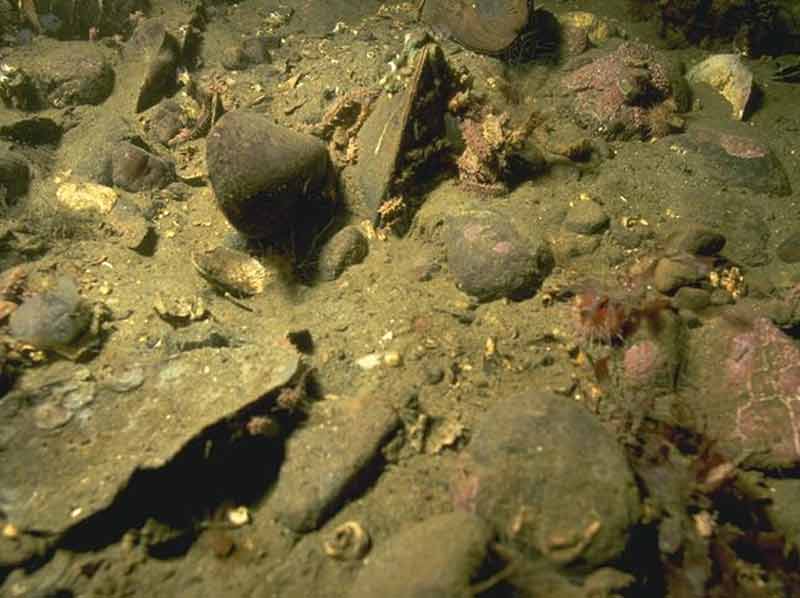A sea cucumber (Ocnus planci)
Distribution data supplied by the Ocean Biodiversity Information System (OBIS). To interrogate UK data visit the NBN Atlas.Map Help
| Researched by | Dr Harvey Tyler-Walters | Refereed by | Admin |
| Authority | (Brandt, 1835) | ||
| Other common names | - | Synonyms | Cucumaria planci (Brandt, 1835) |
Summary
Description
A large sea cucumber up to 15 cm long and 3.5 cm in diameter but usually smaller. The body is tough, stiff, smooth and slightly angular. Usually russet, dark or purple-brown in colour, often with spots or dark lines between each of the five body sections. Tube feet are lighter in colour than the body and arranged in five double rows. The eight large and two small feeding tentacles are branched, leaf-like, and lighter in colour than the body.
Recorded distribution in Britain and Ireland
Recorded from Wider Firth, Orkney; off Runswick Bay, east England; Dogger Bank; Tremadoc Bay, north Wales; southern Ireland; Carlingford and Strangford Lough, Northern Ireland, and sea lochs and inlets of western Scotland.
Global distribution
Recorded from Portugal, the Mediterranean and West Africa (Senegal).
Habitat
Found on soft muddy sediments in areas of moderate to weak water flow at depths of 2 -175 m. It is epifaunal, congregating on rises in the substratum, pebbles, cobbles, sessile invertebrates or on the fronds of algae.
Depth range
-Identifying features
- Tube feet arranged in double rows.
- Body russet brown and skin smooth.
- Eight large and two small, ventral feeding tentacles.
- Spicules in body wall, mainly knobbed button shaped plates with more than 4 holes, with superficial, small, flat baskets.
Additional information
Ocnus planci is the unique characterizing species of the biotope IMU.Ocn (see review for details). Ocnus brunneus may be a smaller form of Ocnus planci. Ocnus brunneus is russet brown in colour, with tube feet singly arranged in five rows, growing up to 2.5 cm in length and 0.5 cm in diameter but usually smaller. The taxonomy of Ocnus planci and Ocnus brunneus was discussed in detail by McKenzie (1984 & 1991). McKenzie (1997) suggested that these species should be recorded separately until their taxonomy had been resolved. McKenzie (1991) noted that Ocnus planci had also been confused with Aslia lefevrei. Therefore, some of the records mapped above may have been mis-identified.
Listed by
Bibliography
Dipper, F.A. & Beaver, R., 1999. Marine Nature Conservation Review Sector 12. Sea lochs in the Clyde Sea: area summaries. Peterborough: Joint Nature Conservation Committee. [Coasts and Seas of the United Kingdom. MNCR Series]
Howson, C.M. & Picton, B.E., 1997. The species directory of the marine fauna and flora of the British Isles and surrounding seas. Belfast: Ulster Museum. [Ulster Museum publication, no. 276.]
Howson, C.M., Connor, D.W. & Holt, R.H.F., 1994. The Scottish sealochs - an account of surveys undertaken for the Marine Nature Conservation Review. Joint Nature Conservation Committee Report, No. 164 (Marine Nature Conservation Review Report MNCR/SR/27)., Joint Nature Conservation Committee Report, No. 164 (Marine Nature Conservation Review Report MNCR/SR/27).
JNCC (Joint Nature Conservation Committee), 1999. Marine Environment Resource Mapping And Information Database (MERMAID): Marine Nature Conservation Review Survey Database. [on-line] http://www.jncc.gov.uk/mermaid
McKenzie, J.D., 1984. Description of a neotype for the holothurian Ocnus brunneus (Forbes MS in Thompson, 1840) from Strangford Lough, Northern Ireland (Holothurioidea; Dendrochirotida). Bulletin of the British Museum (Natural History), Zoology series, 47, 265-272.
McKenzie, J.D., 1991. The taxonomy and natural history of north European dendrochirote holothurians (Echinodermata). Journal of Natural History, 25, 123-171.
McKenzie, J.D., 1997. Echinodermata. In The species directory of the marine fauna and flora of the British Isles and surrounding seas (ed. C.M. Howson & B. Picton), pp. 288-295.
Mortensen, T.H., 1927. Handbook of the echinoderms of the British Isles. London: Humphrey Milford, Oxford University Press.
Murray, E., Dalkin, M.J., Fortune, F. & Begg, K., 1999. Marine Nature Conservation Review Sector 2. Orkney: area summaries. Peterborough: Joint Nature Conservation Committee. [Coasts and sea of the United Kingdom. MNCR Series.]
Ölscher E.M. & Fedra, K., 1977. On the ecology of a suspension feeding benthic community: filter efficiency and behaviour. In Biology of benthic organisms (ed. B.F. Keegan, P.O. Ceidigh & P.J.S. Boaden), pp. 483-492. Oxford: Pergamon Press.
Picton, B.E., 1993. A field guide to the shallow-water echinoderms of the British Isles. London: Immel Publishing Ltd.
Southward, E.C. & Campbell, A.C., 2006. Echinoderms. The Linnean Society of London. Avon: The Bath Press. [Synopses of the British Fauna No. 56.]
Datasets
Centre for Environmental Data and Recording, 2018. Ulster Museum Marine Surveys of Northern Ireland Coastal Waters. Occurrence dataset https://www.nmni.com/CEDaR/CEDaR-Centre-for-Environmental-Data-and-Recording.aspx accessed via NBNAtlas.org on 2018-09-25.
Manx Biological Recording Partnership, 2022. Isle of Man historical wildlife records 1990 to 1994. Occurrence dataset:https://doi.org/10.15468/aru16v accessed via GBIF.org on 2024-09-27.
NBN (National Biodiversity Network) Atlas. Available from: https://www.nbnatlas.org.
OBIS (Ocean Biodiversity Information System), 2025. Global map of species distribution using gridded data. Available from: Ocean Biogeographic Information System. www.iobis.org. Accessed: 2025-08-08
Citation
This review can be cited as:
Last Updated: 19/11/2002



